West Wales is home to a diverse range of bird species thanks to its varied landscape of mountains, moorlands, grasslands, and coastal areas.
From majestic raptors to colourful songbirds, this region boasts an impressive array of avian life that enchants birdwatchers and nature enthusiasts alike.
The region is also an important habitat for migratory birds, which use West Wales as a stopover or breeding ground during their long journeys worldwide.
Whether you’re a seasoned birdwatcher or a casual observer, exploring the birdlife of West Wales is an enriching and rewarding experience.
This article will look closely at some of the most fascinating bird species that call this region their home.
9 Birds You Should Know In West Wales
West Wales is a beautiful region known for its diverse natural landscapes and rich birdlife. Here are nine birds you should know if you plan to explore this area:
1. Red Kite
The Red Kite is a magnificent bird of prey belonging to the family Accipitridae. It can be found in western Europe and northwest Africa, where it breeds, while also occurring occasionally in northern Iran.
These birds are medium-large in size, with wingspans ranging from 125 cm to 170 cm wide. They have reddish brown plumage on their upper parts and pale grey underneath.
The Red Kite feeds mainly on small mammals, carrion, and insects, which they hunt for by soaring through the air using thermals to gain altitude before diving down onto their prey.
Furthermore, this species has adapted well to human presence since it often scavenges near roadsides or rubbish dumps as an easy food source.
All things considered, these majestic creatures make up a beautiful part of our natural environment that should definitely not go unnoticed.
Scientific classification:
| Kingdom | Animalia |
| Phylum | Chordata |
| Class | Aves |
| Order | Accipitriformes |
| Family | Accipitridae |
| Genus | Milvus |
| Species | M. milvus |
Also Featured In: Native Birds Of Germany, Common Slovakian Birds
2. Eurasian Sparrowhawk
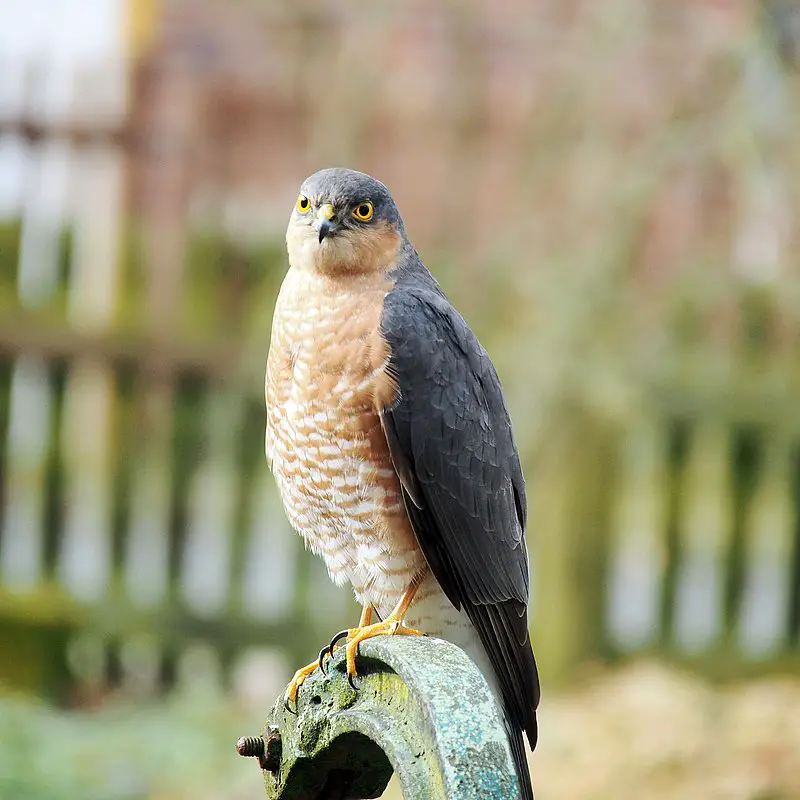
The Eurasian sparrowhawk is a small bird of prey from the Accipitridae family. It has distinct blue-grey upperparts and orange barred underparts, while females and juveniles appear brown with brown barring underneath.
The females of this species can grow up to 25% larger than males, which makes it one of the largest size differences among birds of its kind.
They are found all over Europe, Asia and North Africa, where they hunt for quarries such as mammals, lizards or even other smaller birds using their powerful talons to catch them from aerial dives.
They have adapted well to human presence by nesting on buildings or urban parks due to a lack of natural habitats, making them interesting creatures for wildlife observation across cities, too.
Scientific classification:
| Kingdom | Animalia |
| Phylum | Chordata |
| Class | Aves |
| Order | Accipitriformes |
| Family | Accipitridae |
| Genus | Accipiter |
| Species | A. nisus |
Also Featured In: Birds of United Kingdom, European Birds
3. Lesser Black-Backed Gull
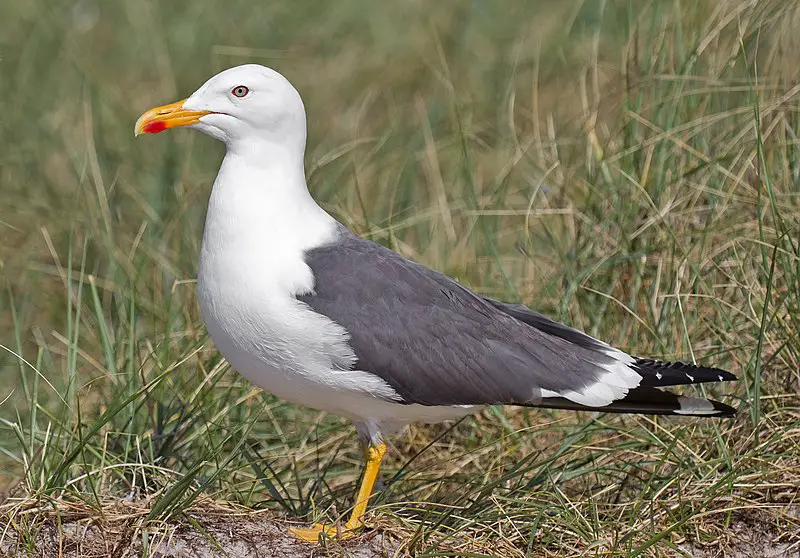
The lesser black-backed gull is a large, migratory bird found along the Atlantic coasts of Europe and North America.
During winter months, they are commonly spotted along the British Isles to West Africa, while in summer, many birds can be seen year-round on both east and west coastlines.
In recent years, the numbers of these birds have risen dramatically, with some winters having great abundance present throughout their range.
They measure around 48cm long, with wingspans reaching 110 cm across when fully grown – making them larger than most other gull species.
These hardy seabirds feed mainly on small fish, crustaceans, molluscs, and carrion or scraps from human activities near coastal areas such as fishing ports or refuse dumpsites.
Scientific classification:
| Kingdom | Animalia |
| Phylum | Chordata |
| Class | Aves |
| Order | Charadriiformes |
| Family | Laridae |
| Genus | Larus |
| Species | L. fuscus |
Also Featured In: Birds found in portugal, Most Common Scotland Birds
4. Oystercatchers
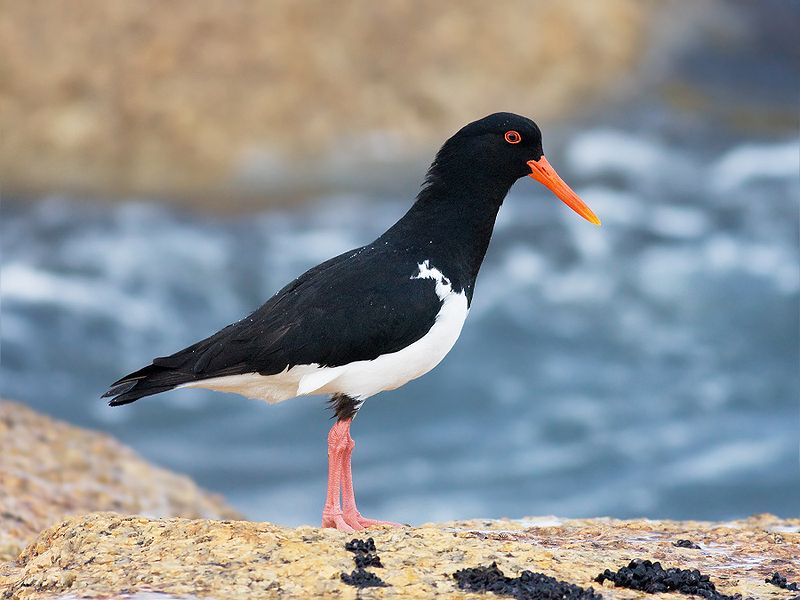
Oystercatchers are a family of waders forming the Haematopodidae, with one genus: Haematopus.
They live in coastal regions worldwide, excluding polar and some tropical areas of Africa & South East Asia.
Eurasian, South Island & Magellanic oystercatcher species also breed far inland – breeding grounds being found much deeper than other family members.
They have long beaks that feed on molluscs such as mussels, clams and oysters, which they crack open using their strong bills.
Oystercatchers are usually quite vocal birds, making various loud calls when disturbed or alarmed.
The males tend to display more brightly coloured plumage than females, who share similar brown/black hues for camouflage purposes during nesting season.
Scientific classification:
| Kingdom | Animalia |
| Phylum | Chordata |
| Class | Aves |
| Order | Charadriiformes |
| Suborder | Charadrii |
| Family | Haematopodidae Bonaparte, 1838 |
| Genus | Haematopus Linnaeus, 1758 |
Also Featured In: Best Birds Watching in Austria, Birds You’ll Find in the Sea
5. Common Gull
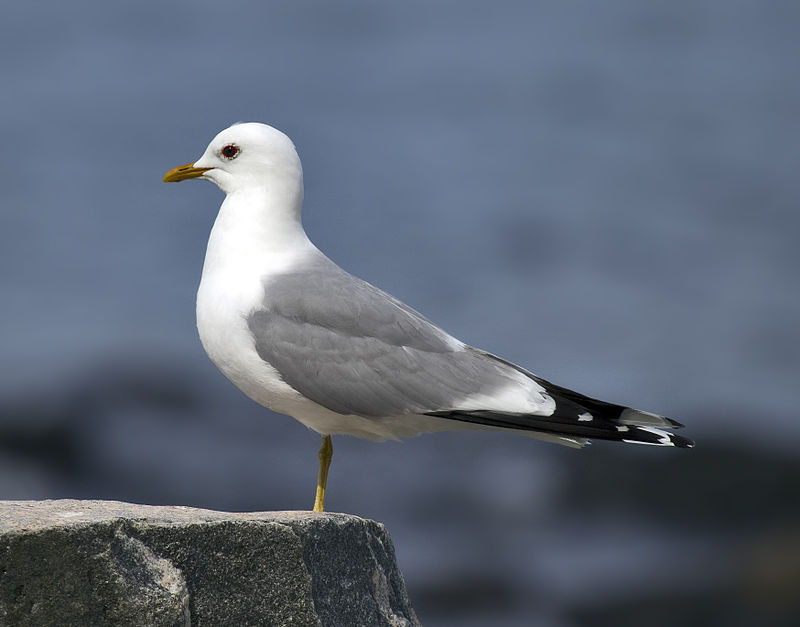
The Common Gull, also known as the Sea Mew, is a medium-sized bird native to northern Europe. It’s closely related to the Short-Billed Gull; both species are sometimes collectively called “Mew Gull”.
During winter months, many Common Gulls migrate further south in search of warmer climates.
The exact origin of its vernacular name remains uncertain, but it may have something to do with its call, which resembles that of a cat meowing.
Its plumage consists mostly of grey and white feathers and black wingtips, making it easily identifiable amongst other gull species.
Scientific classification:
| Kingdom | Animalia |
| Phylum | Chordata |
| Class | Aves |
| Order | Charadriiformes |
| Family | Laridae |
| Genus | Larus |
| Species | L. canus |
Also Featured In: Norway Birds, Birds that Live in Vancouver
6. European Herring Gull
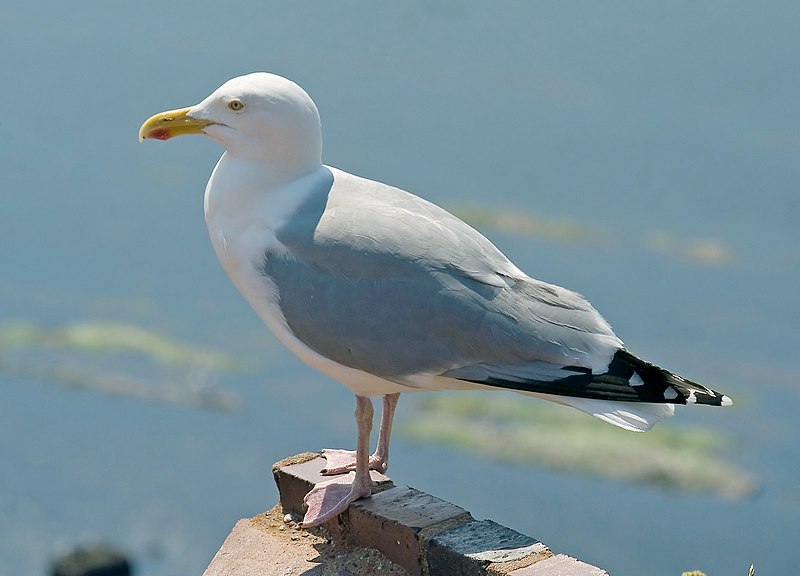
The European herring gull is one of the most recognizable birds, easily spotted along the shorelines of Western Europe.
It has a wingspan of up to 66 cm long and can nest across Northern Europe, Central Europe, Eastern Europe and Scandinavia.
During colder months, many European herring gulls migrate further south in search of warmer temperatures, which allows them to survive better during wintertime.
As scavengers, they often take advantage of human debris or waste as food sources near populated areas such as beaches, parks and cities; however, their diet also consists of fish, insects and other small animals that live near coastal regions.
Despite being common in some parts of its range, this species may have experienced population declines due to habitat loss caused by human activities like urbanization but still remains abundant in others thanks to conservation efforts implemented over time by local authorities worldwide.
Scientific classification:
| Kingdom | Animalia |
| Phylum | Chordata |
| Class | Aves |
| Order | Charadriiformes |
| Family | Laridae |
| Genus | Larus |
| Species | L. argentatus |
Also Featured In: Ireland Birds, Amsterdam Birds You Should Know
7. Great Black-Backed Gull
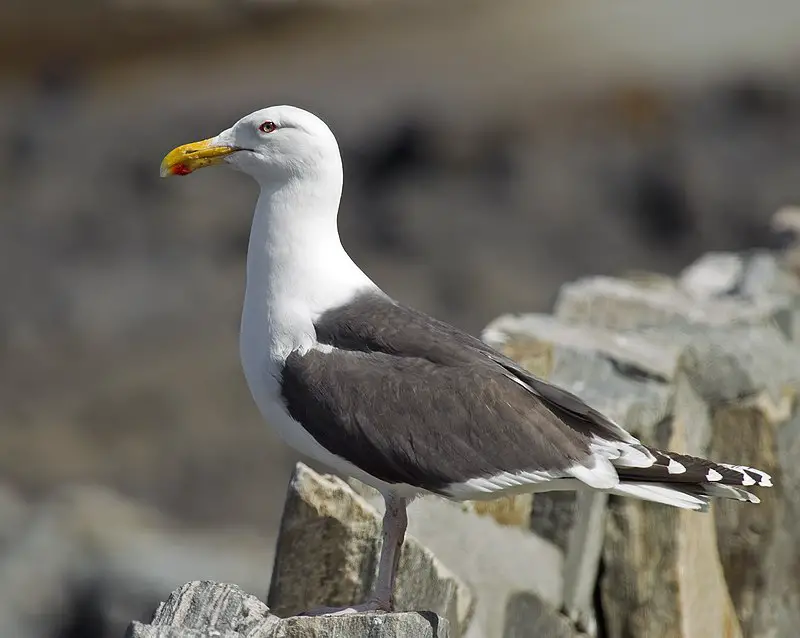
The Great Black-Backed Gull is the largest member of its family and is aptly named “king of the Atlantic waterfront”.
It can be found on both European and North American coasts, islands in the North Atlantic, or farther inland near large lakes.
This seabird is an aggressive hunter who tends to scavenge for food it may not have caught.
In addition to their formidable hunting skills, they are adept at stealing from other birds who have successfully managed to catch something.
As such, they are known for being very territorial when defending their nests during mating season.
The powerful wingspan of this majestic species makes them able to soar through even strong winds but still remain graceful while doing so.
All these characteristics combined show why great black-backed gulls truly live up to their name as kings among seafaring birds.
Scientific classification:
| Kingdom | Animalia |
| Phylum | Chordata |
| Class | Aves |
| Order | Charadriiformes |
| Family | Laridae |
| Genus | Larus |
| Species | L. marinus |
Also Featured In: Iceland birds, Birds of Nova Scotia
8. Common Linnet
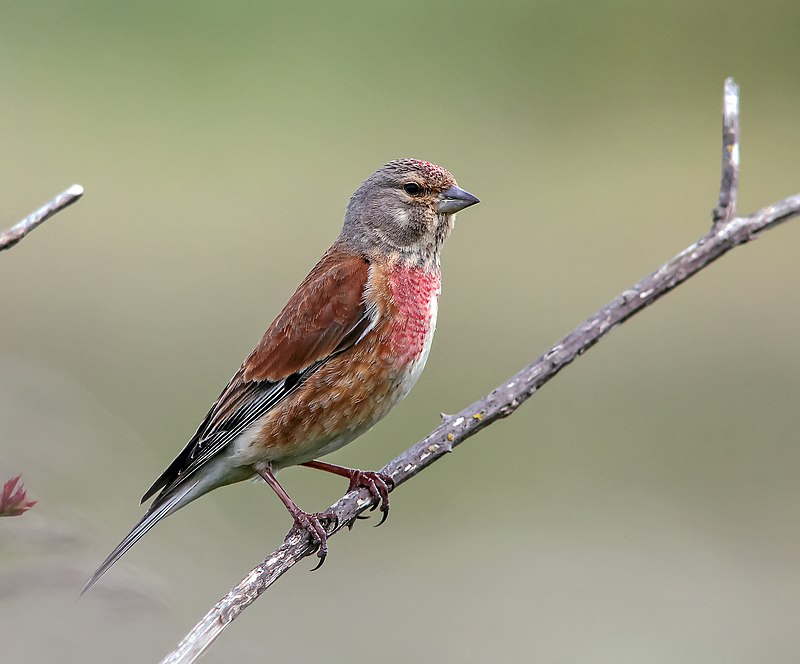
The common linnet is a small bird from the finch family Fringillidae. It is known for its love of hemp and flax seeds, hence its scientific name Linaria.
The bird is sometimes called ‘flaxseed’, which is derived from flax, one of the plants used to make linen.
The common linnet was named by the famous Swedish naturalist Carl Linnaeus in his book Systema Naturae in 1758.
They have a small body size and are characterized by their distinctive red forehead and breast, with dark brown patches on the back and wings.
The bird is a native of Europe, North Africa, and Western Asia and can be found in open fields, farmland, and gardens.
The common linnet is a social bird and often forms flocks during non-breeding seasons.
Overall, the common linnet is a beautiful and intriguing bird species.
Scientific classification:
| Kingdom | Animalia |
| Phylum | Chordata |
| Class | Aves |
| Order | Passeriformes |
| Family | Fringillidae |
| Subfamily | Carduelinae |
| Genus | Linaria |
| Species | L. cannabina |
Also Featured In: Most Common Songs Birds that Live around You,
9. Curlews
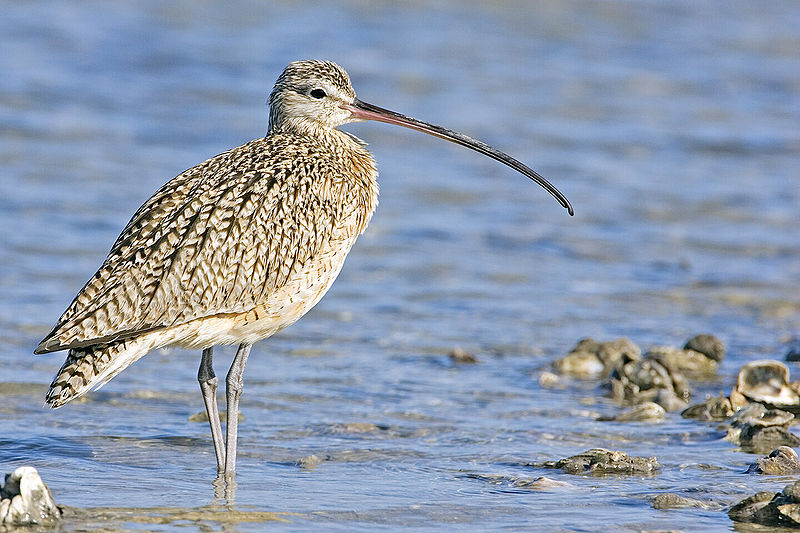
Curlews are a type of bird known for their distinctive long and slender bills that curve downwards. They have mottled brown plumage, which helps them blend into their habitat.
The English name, curlew, may have been influenced by the French word corliu, meaning messenger. The name also imitates the Eurasian Curlew’s call, which is distinctive and easily recognizable.
The group consists of nine species of birds in the genus Numenius, which are found worldwide. Curlews were first recorded in Langland’s Piers Plowman in 1377.
They are known for their unique appearance and behaviour, making them a fascinating and sought-after bird for birdwatchers and enthusiasts.
Scientific classification:
| Kingdom | Animalia |
| Phylum | Chordata |
| Class | Aves |
| Order | Charadriiformes |
| Family | Scolopacidae |
| Genus | Numenius Brisson, 1760 |
Also Featured In: Moorland Birds You Need to Know,
Conclusion
West Wales is a treasure trove for bird enthusiasts, offering a captivating blend of coastal, wetland, and woodland habitats that are home to a remarkable array of bird species.
The nine birds highlighted in this region represent the diversity of avian life found in this picturesque part of the world.
From the iconic Red Kite soaring overhead to the charming and comical Puffin along the coastline, West Wales is a haven for both resident and migratory birds.
Whether you’re an avid birder or simply a nature lover, exploring the avian wonders of West Wales promises to be a rewarding and unforgettable experience, making it a must-visit destination for birdwatchers and wildlife enthusiasts alike.